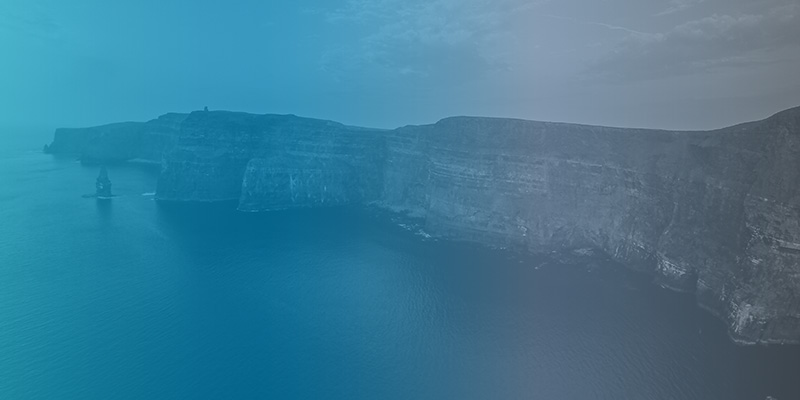Ireland enjoys surprisingly varied scenery from hair raising coastal cliffs with magnificent sea views to the many acres of wild and windswept countryside. There are many picture postcard villages to explore and you are always guaranteed to enjoy a warm Irish welcome. These are 10 of the most beautiful places to visit in Ireland.
1. Cliffs of Moher

Ireland’s mighty Cliffs of Moher reign strong as one of the country’s most visited natural attractions – towering 214 meters over the Atlantic Ocean in western Ireland. The iconic cliffs run from near the village of Doolin for around 8km to Hags Head in County Clare and host the country’s most spectacular coastal walk. Carved out by a gigantic river delta around 320 million years ago, the imposing cliffs also offer incredible views, stretching over Galway Bay, the distant Twelve Pins mountain range and the northern Maum Turk Mountains.


2. Ring of Kerry

Ireland’s most scenic tourist trail, the Ring of Kerry, runs 120 miles through some of southwestern Ireland’s most jaw-dropping landscapes. A patchwork of lush meadows, glacial lakes and heather-topped mountains, the Ring of Kerry includes highlights like the rugged Beara Peninsula and the Kerry Way – Ireland’s longest and oldest walking route. Stop off en route at the Killarney National park, a UNESCO World Heritage biosphere reserve, home to the 15th century Ross Castle and a herd of wild red deer.
3. The Giant’s Causeway

Northern Ireland’s only UNESCO World Heritage-listed site, the Giant’s Causeway is proof that Mother Nature provides the most dramatic tourist attractions. The natural wonder is comprised of around 40,000 polygonal basalt rock columns, formed by the ancient volcanic landscape and stretching along the coastline like a series of gigantic stepping stones. A Giants Causeway Day Trip from Belfast is one of the country’s most popular excursions, with visitors taking the unique opportunity to walk one of nature’s most peculiar pathways.


4. The Skellig Islands

Ireland’s magnificent UNESCO World Heritage Skellig Islands make a worthy side trip from the popular Ring of Kerry tourist trail, a pair of small rocky mounds that rise up from the sea off the coast of Portmagee. Not only are the two islands – Skellig Michael and Little Skellig – home to a fascinating 6th-century monastic complex perched on the 230-meter high cliff top, but they also host an impressive array of birdlife. Look out for Gannets, Black Guillemots, Cormorants, Razorbills and Herring Gulls as you climb the hair-raisingly steep 600-step climb to view the monastic remains.
5. Aran Islands

Famous for their traditional knitted ‘Aran sweaters’ (sold all over the world) and car-free roads, the Aran Islands are one of few places left where you can experience a traditional Irish village, unmarred by the modern developments of the mainland. Here, many locals still speak Gaelic as their first language, live in small farming communities and drive pony traps. The countryside is equally enchanting – historic forts teetering on cliff tops, endless sandy beaches and miles of rugged coastline.


6. The Wild Atlantic Way

The Wild Atlantic Way is a 2,400 km road trip that follows the west coast of Ireland, from Malin head in County Donegal to Kinsale in County Cork. Along the way drivers will be passing through unspoilt villages, along rugged coastline and epic panoramas. The route passes through 156 strategically placed discovery points. The route will provide access to some of the very best experiences Ireland has to offer. It is hoped that the route will encourage people to interact with local people, and therefore gain a better understanding of Ireland, it’s history and it’s culture.
7. The Burren

A mind-boggling landscape of ruts, fissures and rocky mounds, walking across the Burren has been likened to walking on the moon. Sculpted through thousands of years of acid erosion, the karst landscape appears like a giant jigsaw of grikes (fissures) and clints (isolated rocks jutting from the surface), teetering 300-meters above the ocean on the coast of County Clare in western Ireland. Be sure to take a closer look as you trek over the rocks, too – the rocky terrain nurtures a surprising variety of rare plants and insects (around 700 different species), with colorful wildflowers blooming between the cracks throughout the spring.


8. Newgrange – The Boyne Valley

The Passage Grave of Newgrange is one of the most historically significant locations in not just Ireland, but in Europe. The Passage Tomb is only rivalled in importance by Stonehenge in Europe. The prehistoric tomb dates back to circa 3000 BC which make the tomb 400 years older than the Great Pyramids of Egypt and 1000 years older than Stonehenge. What makes Newgrange particularly special is that on the winter solstice annually, a beam of sunlight travels the length of the tomb and illuminates the floor. Newgrange is a designated World Heritage Site by UNESCO and attracts in the region of 200,000 visitors annually. Each tour takes up to 15 people into the tomb itself. Tours through the passage tomb use false lighting to simulate the winter solstice.
9. Glendalough

A popular day trip from Dublin, Glendalough, or the ‘Valley of Two Lakes’, is one of Ireland’s most prominent monastic sites, nestled in the heart of the Wicklow Mountains National Park. The 6th century Christian settlement was founded by St. Kevin and boasts a series of impressive remains set against a backdrop of picturesque Irish countryside. Nicknamed ‘The Garden of Ireland’, Wicklow is a nature lover’s paradise of rolling meadows, vast lakes and hillsides carpeted in purple heather.


10. Cooley Peninsula

At the northeastern tip of Ireland, the remote Cooley Peninsula juts out into the Irish Sea just below the border of Northern Ireland and while the region remains largely free of tourists, there’s still plenty of stunning scenery to take in. Enjoy the views from the forested Mourne Mountains, stop off at the charming medieval village of Carlingford and walk the windswept coastline in one of the country’s most rewarding off-the-beaten-track destinations.

